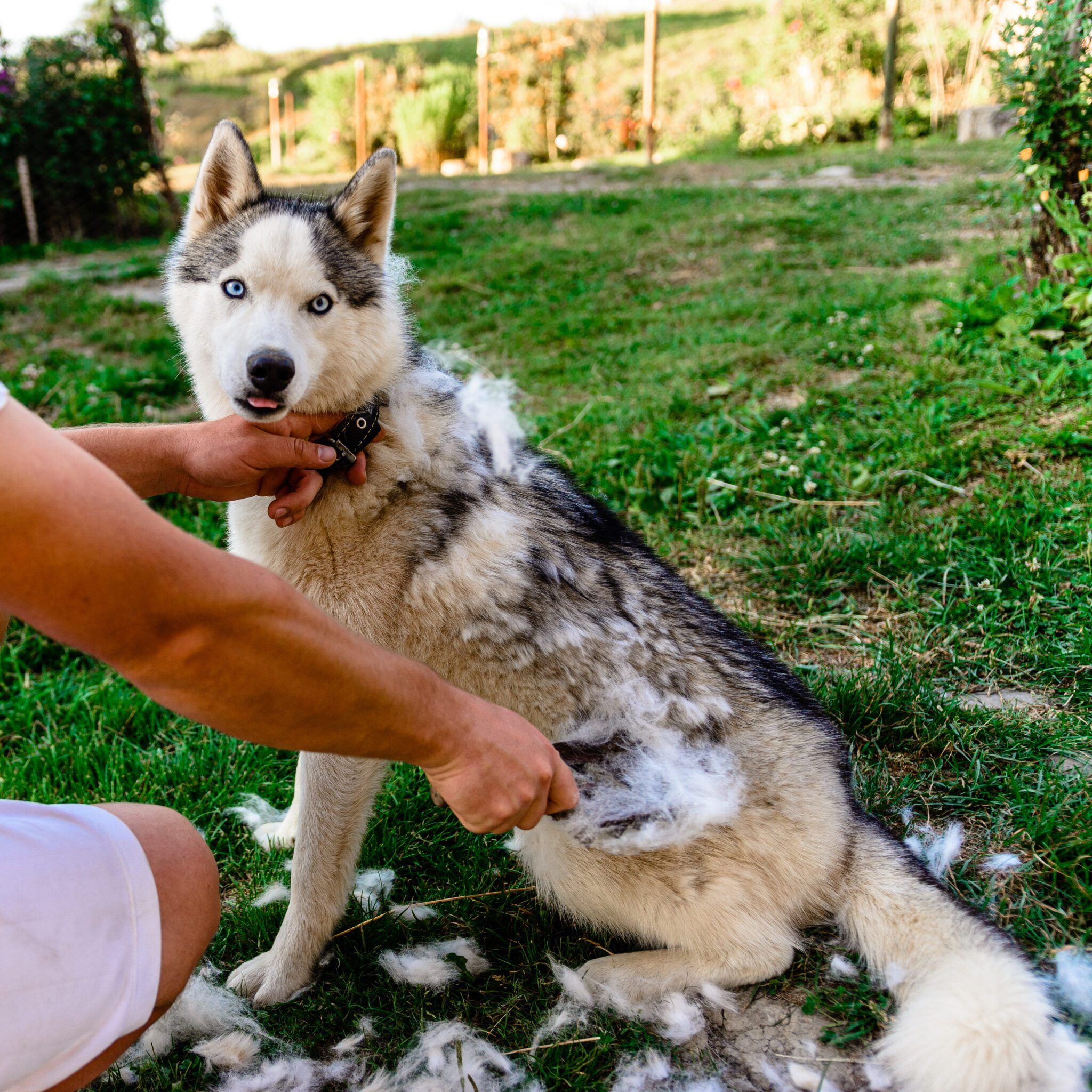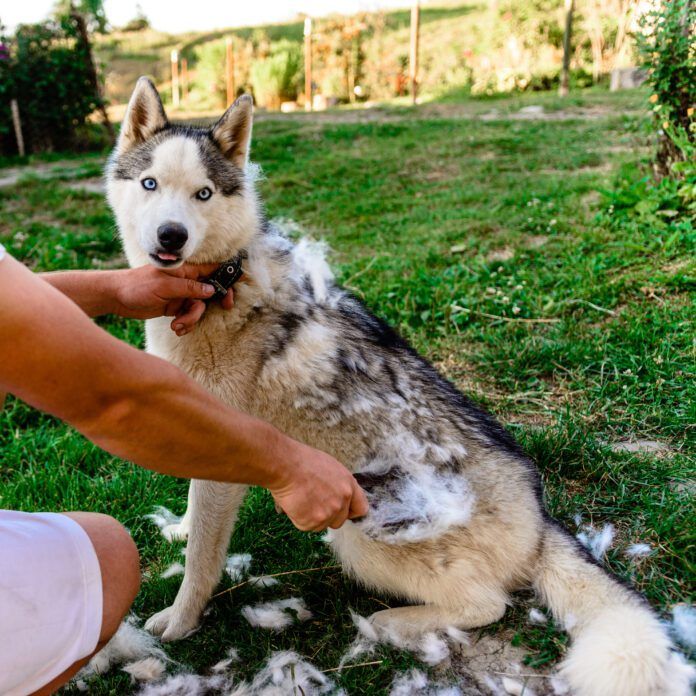All dogs shed, but some shed a lot more than others. Shedding removes old, damaged, or excess hair in a natural cycle that regulates body temperature and maintains skin and coat condition. The rate and timing of your dog’s hair loss depend on age, breed, and overall health.
Breed Can Influence Shedding
Some dogs lose only a little hair throughout the year while others shed heavily when seasons change, and some dogs shed every day of their lives. Among purebred dogs, the heaviest shedders are:
- Siberian Huskies
- Alaskan Malamutes
- German Shepherds
- Golden Retrievers
- Labrador Retrievers
- Dalmatians
- Akitas
- Chow Chows
These dogs shed more because they are double-coated. The outer layer of a dog’s hair is the topcoat, also known as guard hairs. The topcoat is usually coarse in texture and effective at repelling water and protecting the skin. In addition, double-coated dogs have an undercoat of short, dense hair that traps air close to the skin, providing insulation and protecting against both heat and cold. Because undercoats grow quickly and shed dramatically, “blowing their coat” is an accurate description when dogs respond to seasonal changes in spring or fall by releasing no-longer-needed hair.
One popular belief is that long-haired dogs shed more than their short-haired cousins, which anyone with a Lab knows is a myth. Another misconception assumes that all Doodle dogs (Poodle crosses) are hypoallergenic and never shed. The truth lies in their DNA, where two key genes (MC5R and RSPO2) determine a dog’s shedding pattern by defining the shape and behavior of hair follicles. Goldendoodles, Labradoodles, Bernedoodles, and Aussiedoodles can shed just like their Golden Retriever, Labrador Retriever, Bernese Mountain Dog, or Australian Shepherd parents. Although many Doodles shed less than other dogs, there is no guarantee that their Poodle genes will control their coats.
Age, Health, and Hair Loss
Puppies shed less than adult dogs because their hair is fine and soft, but when their adult coats grow in, which usually happens by six months of age, puppies can lose a lot of hair.
Most healthy adult dogs develop a predictable shedding pattern and their coats’ behavior remains constant through middle age. In contrast, senior coats become thinner, less dense, and more prone to matting, all of which can change their shedding schedules.
If at any age your dog’s skin becomes flaky, discolored, or patchy, or if the coat becomes dull and dry, there may be an underlying medical condition. Skin parasites (fleas, ticks, or mites), hormonal imbalances, autoimmune disorders, bacterial or fungal infections, physical injuries, pregnancy, and even the stress of 4th of July fireworks, relocations, or other interruptions of a dog’s comfortable routines can trigger hair loss. So can environmental allergies to pollen or grass. Schedule a checkup if unusual symptoms accompany excessive shedding, such as weight gain, fatigue, excessive itching, or increased thirst or urination.
How Seasonal Changes Affect Shedding
Double-coated dogs, including those who shed every day, are notorious for heavy shedding as they react to changing daylight hours and warming temperatures by releasing their winter coats in spring. They may also shed as winter approaches and their bodies prepare for new insulating hair growth by releasing their summer coats. In other words, heavy shedding in spring, fall, or early winter can be normal and predictable.
What to Do with All That Dog Hair
Cleaning up after a shedding dog can seem an unending task, but technology helps. For the latest in vacuums that handle shed hair, see the Bissell Pet Hair Vacuum,
Hoover WindTunnel Tangle Guard Upright Vacuum, Kenmore Pet-Friendly Bagged Upright Vacuum, or Black & Decker Furbuster Cordless Handheld Pet Vacuum.
Tiny polyester fibers in Swiffer Pet Floor Sweeping Cloths and in other dry Swiffer cloths create a static charge that attracts and removes dog hair, dirt, and dust particles from hard floors. The highly rated Turbo Microfiber Mop Floor Cleaning System can be used wet or dry to trap and remove pet hair.
Air purifiers pull household air through a filtration system, capturing and trapping microscopic pet allergens, odor, dander, and hair. Recommended filters for homes with shedding dogs include the Bissell Air400 Air Purifier, Levoit Advanced Air Purifier for Pets, and BlueAir 311i Max Pet Dander Air Purifier.
Since its introduction in 2012, the ChomChom Roller Pet Hair Remover has won rave reviews from Consumer Reports, the Good Housekeeping Institute, and other organizations for its effect on furniture, pillows, and even carpet. It’s the only tested tool that gathers and collects all the pet hair it touches with simple forward-and-backward swipes. For use on clothing, try the Evercare Extreme Stick Lint Roller. To remove dog hair from clothes in your laundry, try Bounce Pet Hair Mega Dryer Sheets, which out-perform other dryer sheets in pet hair laundry tests.
Can You Reduce Shedding at the Source?
Yes. You can often reduce how much your dog sheds by improving her diet along with doing basic grooming and routine maintenance such as regular brushing and bathing.
Nutrition and Shedding
Nutritional deficiencies contribute to shedding because the strength and flexibility of guard hairs and undercoat depend on the quality of protein and other nutrients in a dog’s diet. Adding fresh protein such as eggs, meat, fish, yogurt, or cottage cheese to your dog’s dry food, can help, and so can upgrading to foods whose first ingredients are meat and meat meal rather than corn, soy, wheat, or legumes. Food allergies or sensitivities can contribute to itchy skin, skin infections, and hair loss. Because dehydration contributes to dry coats and shedding, give your dog extra bowls of fresh, clean water and add warm water, bone broth, or goat milk to his dinner, especially when winter weather and indoor heating dry the air.
Brush and Brush Some More
Brushing can remove excess hair before it lands on your floor.
- Slicker brushes, such as those from Chris Christensen, feature short, tightly packed wire pins that are angled to remove loose hair while avoiding the skin. Slickers are versatile and work well on different types of coats, especially wire-coated, curly-coated, medium-coated, and long-coated dogs. Some are self-cleaning, thanks to a button that retracts the brush’s wire pins.
- Bristle brushes, like the Kenchii Boar and Nylon Grooming Brush, are made with natural or synthetic bristles and work well on short-coated dogs. Use as a finishing brush on double-coated dogs.
- Pin brushes, like the Andis Medium Pin Brush, are covered with medium-spaced wire pins, often with rubber tips to prevent skin injury. They work well as finishing brushes for long-haired dogs and to remove tangles from wire-coated dogs. Some double-sided dog brushes, such as the Hartz Combo Brush, have pins on one side and bristles on the other.
- Resembling curry combs for horses, shedding blades for dogs, such as the Frisco Shedding Blade Dog Brush, remove loose or dead hair and reduce shedding with a single metal blade that has coarse teeth for thick coats on one side and fine teeth for shorter coats on the other. The handle separates to create a single blade to cover larger areas.
- The most popular and well-known shedding tool for double-coated dogs is the FURminator, whose stainless steel edge reaches through guard hairs to remove loose hair and undercoat without damaging the topcoat or injuring the dog’s skin.
- HandsOn Shedding Dog Gloves are covered with non-abrasive, flexible rubber nodules that massage the skin while removing excess hair. They can be used wet or dry and are appropriate for all breeds, plus cats and horses.
- Rubber or silicone curry combs or bath brushes, like the Kong ZoomGroom, double as massage tools and grooming brushes.
- Stainless steel grooming combs, like the 10″ Andis Steel Comb, work well on wet dogs covered with shampoo or conditioner. In fact, combing your dog as you condition his coat can remove substantial amounts of soon-to-shed hair.
Bathing Helps Reduce Shedding
Several shampoos and conditioners claim to control or reduce shedding, such as
EZ Out Deshedding Shampoo, Coat Handler’s Undercoat Control Deshedding Dog Conditioner, Furminator’s deShedding Shampoo, Earthbath Shed Control Shampoo, and Nature’s Miracle Shed Control Shampoo & Conditioner. Most contain herbal ingredients like aloe vera or green tea, natural oils like shea butter, nutrients like vitamins A, D, and E, or omega-3 and -6 fatty acids. Groomers often describe conditioning as a final step that detangles, moisturizes, and seals hair shafts, protecting the coat from injury, improving its overall appearance, and releasing loose hair before it can shed.
Follow your grooming product’s label instructions for best results. Most recommend that you brush your dog’s dry coat well, remove excess hair with a de-shedding tool, then bathe your dog. Follow shampoo recommendations, which may involve working the product into your dog’s wet coat and letting it stand for 5 to 10 minutes before rinsing. Do the same with a conditioner, if you’re using one. Rinse well and towel dry. A force dryer, such as the Shelandy Pet Dryer, can remove shedding hair while drying your dog. When the coat is dry, follow with additional brushing.
No shampoo or conditioner can prevent your dog from releasing dead hair, but when combined with regular brushing and appropriate tools, shed-control grooming products can help your dog maintain a healthy coat while you maintain a (mostly) shed-free home.

